Leadership Styles and Organisational Situations: Lessons from Shackleton and Morrison
VerifiedAdded on 2023/06/09
|8
|2053
|83
AI Summary
This report analyses Shackleton's leadership style and the important lessons learned from the article in the context of contemporary business organisations in the crises. It also evaluates an organisational situation with the help of schools of leadership and makes recommendations for improving performance and enhancing values for the chosen organisation.
Contribute Materials
Your contribution can guide someone’s learning journey. Share your
documents today.
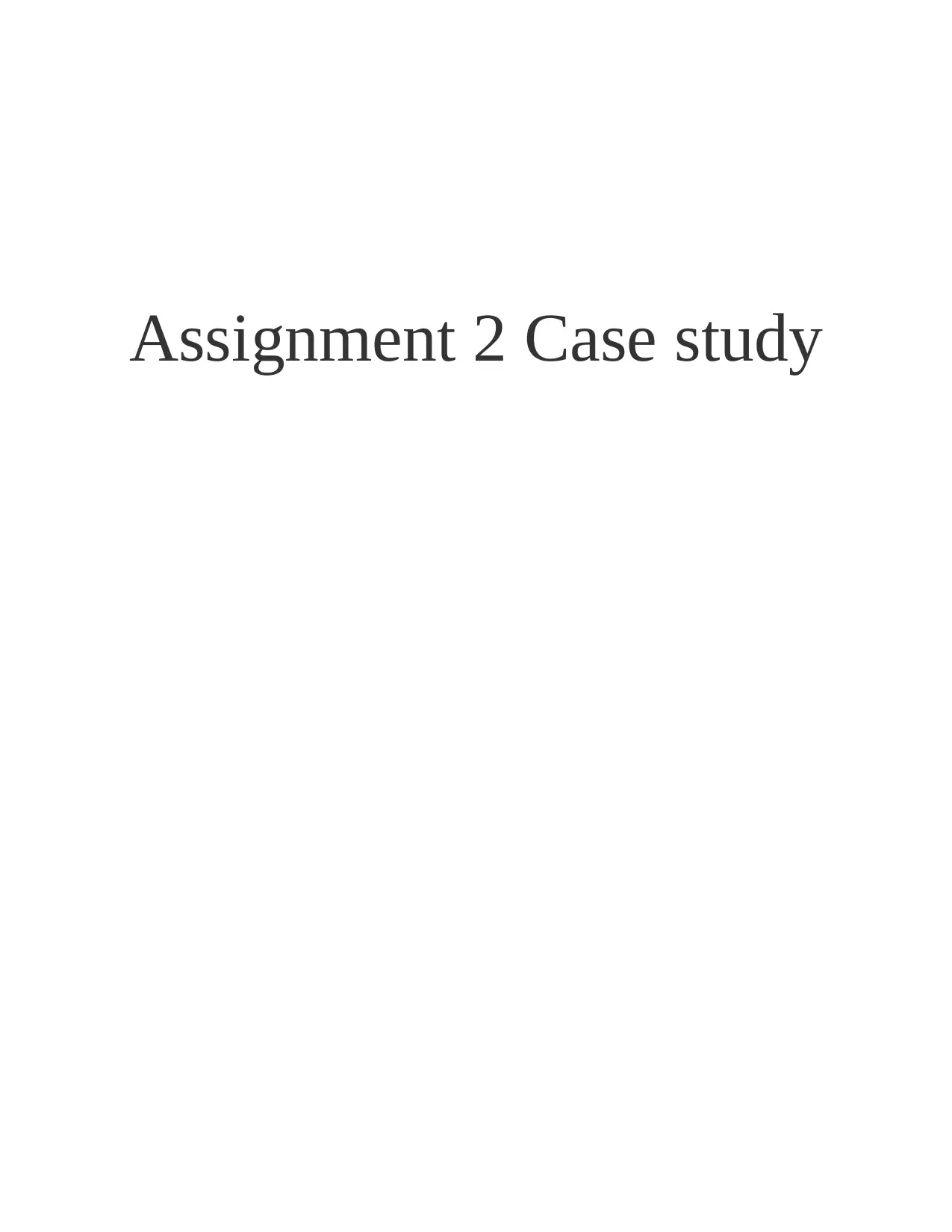
Assignment 2 Case study
Secure Best Marks with AI Grader
Need help grading? Try our AI Grader for instant feedback on your assignments.
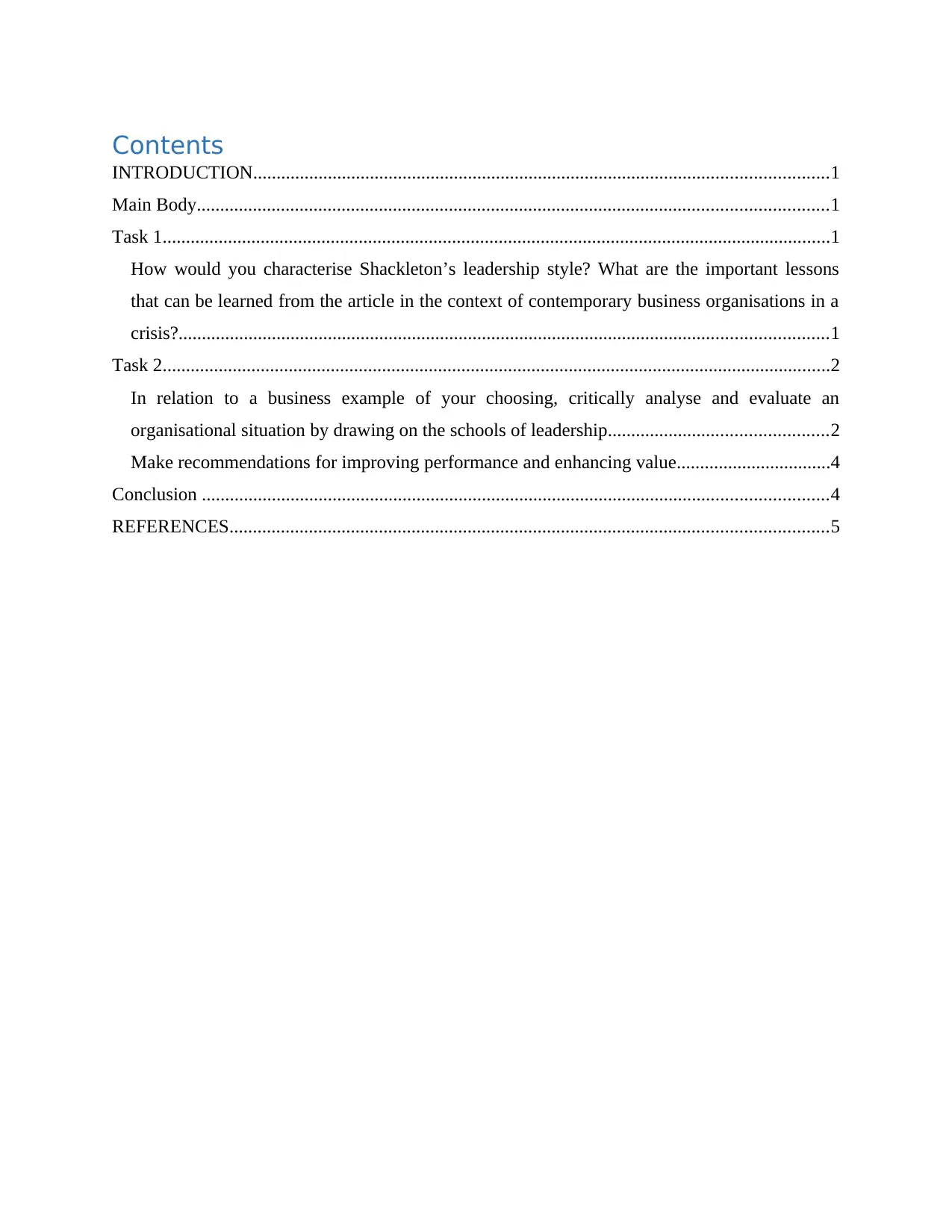
Contents
INTRODUCTION...........................................................................................................................1
Main Body.......................................................................................................................................1
Task 1...............................................................................................................................................1
How would you characterise Shackleton’s leadership style? What are the important lessons
that can be learned from the article in the context of contemporary business organisations in a
crisis?...........................................................................................................................................1
Task 2...............................................................................................................................................2
In relation to a business example of your choosing, critically analyse and evaluate an
organisational situation by drawing on the schools of leadership...............................................2
Make recommendations for improving performance and enhancing value.................................4
Conclusion ......................................................................................................................................4
REFERENCES................................................................................................................................5
INTRODUCTION...........................................................................................................................1
Main Body.......................................................................................................................................1
Task 1...............................................................................................................................................1
How would you characterise Shackleton’s leadership style? What are the important lessons
that can be learned from the article in the context of contemporary business organisations in a
crisis?...........................................................................................................................................1
Task 2...............................................................................................................................................2
In relation to a business example of your choosing, critically analyse and evaluate an
organisational situation by drawing on the schools of leadership...............................................2
Make recommendations for improving performance and enhancing value.................................4
Conclusion ......................................................................................................................................4
REFERENCES................................................................................................................................5

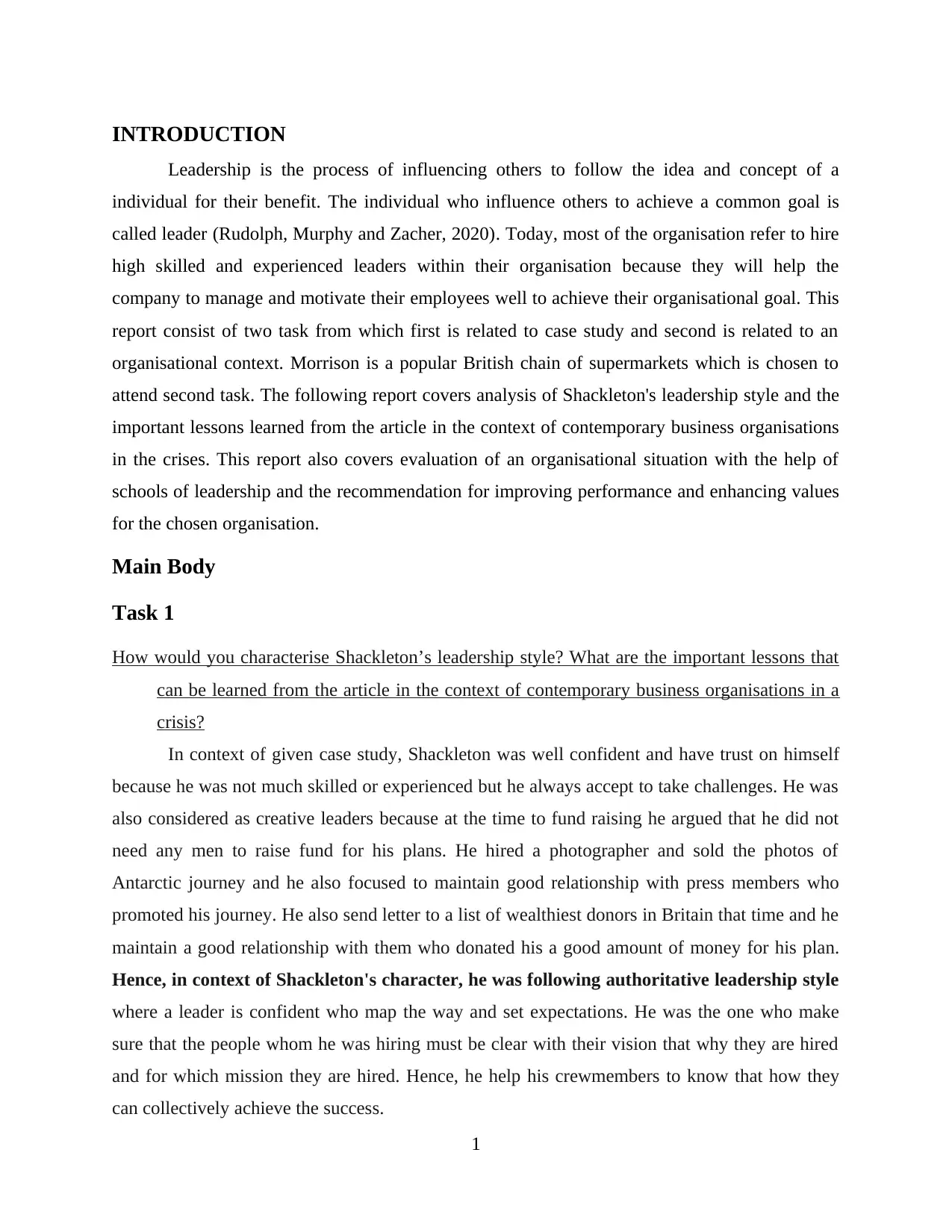
INTRODUCTION
Leadership is the process of influencing others to follow the idea and concept of a
individual for their benefit. The individual who influence others to achieve a common goal is
called leader (Rudolph, Murphy and Zacher, 2020). Today, most of the organisation refer to hire
high skilled and experienced leaders within their organisation because they will help the
company to manage and motivate their employees well to achieve their organisational goal. This
report consist of two task from which first is related to case study and second is related to an
organisational context. Morrison is a popular British chain of supermarkets which is chosen to
attend second task. The following report covers analysis of Shackleton's leadership style and the
important lessons learned from the article in the context of contemporary business organisations
in the crises. This report also covers evaluation of an organisational situation with the help of
schools of leadership and the recommendation for improving performance and enhancing values
for the chosen organisation.
Main Body
Task 1
How would you characterise Shackleton’s leadership style? What are the important lessons that
can be learned from the article in the context of contemporary business organisations in a
crisis?
In context of given case study, Shackleton was well confident and have trust on himself
because he was not much skilled or experienced but he always accept to take challenges. He was
also considered as creative leaders because at the time to fund raising he argued that he did not
need any men to raise fund for his plans. He hired a photographer and sold the photos of
Antarctic journey and he also focused to maintain good relationship with press members who
promoted his journey. He also send letter to a list of wealthiest donors in Britain that time and he
maintain a good relationship with them who donated his a good amount of money for his plan.
Hence, in context of Shackleton's character, he was following authoritative leadership style
where a leader is confident who map the way and set expectations. He was the one who make
sure that the people whom he was hiring must be clear with their vision that why they are hired
and for which mission they are hired. Hence, he help his crewmembers to know that how they
can collectively achieve the success.
1
Leadership is the process of influencing others to follow the idea and concept of a
individual for their benefit. The individual who influence others to achieve a common goal is
called leader (Rudolph, Murphy and Zacher, 2020). Today, most of the organisation refer to hire
high skilled and experienced leaders within their organisation because they will help the
company to manage and motivate their employees well to achieve their organisational goal. This
report consist of two task from which first is related to case study and second is related to an
organisational context. Morrison is a popular British chain of supermarkets which is chosen to
attend second task. The following report covers analysis of Shackleton's leadership style and the
important lessons learned from the article in the context of contemporary business organisations
in the crises. This report also covers evaluation of an organisational situation with the help of
schools of leadership and the recommendation for improving performance and enhancing values
for the chosen organisation.
Main Body
Task 1
How would you characterise Shackleton’s leadership style? What are the important lessons that
can be learned from the article in the context of contemporary business organisations in a
crisis?
In context of given case study, Shackleton was well confident and have trust on himself
because he was not much skilled or experienced but he always accept to take challenges. He was
also considered as creative leaders because at the time to fund raising he argued that he did not
need any men to raise fund for his plans. He hired a photographer and sold the photos of
Antarctic journey and he also focused to maintain good relationship with press members who
promoted his journey. He also send letter to a list of wealthiest donors in Britain that time and he
maintain a good relationship with them who donated his a good amount of money for his plan.
Hence, in context of Shackleton's character, he was following authoritative leadership style
where a leader is confident who map the way and set expectations. He was the one who make
sure that the people whom he was hiring must be clear with their vision that why they are hired
and for which mission they are hired. Hence, he help his crewmembers to know that how they
can collectively achieve the success.
1
Secure Best Marks with AI Grader
Need help grading? Try our AI Grader for instant feedback on your assignments.
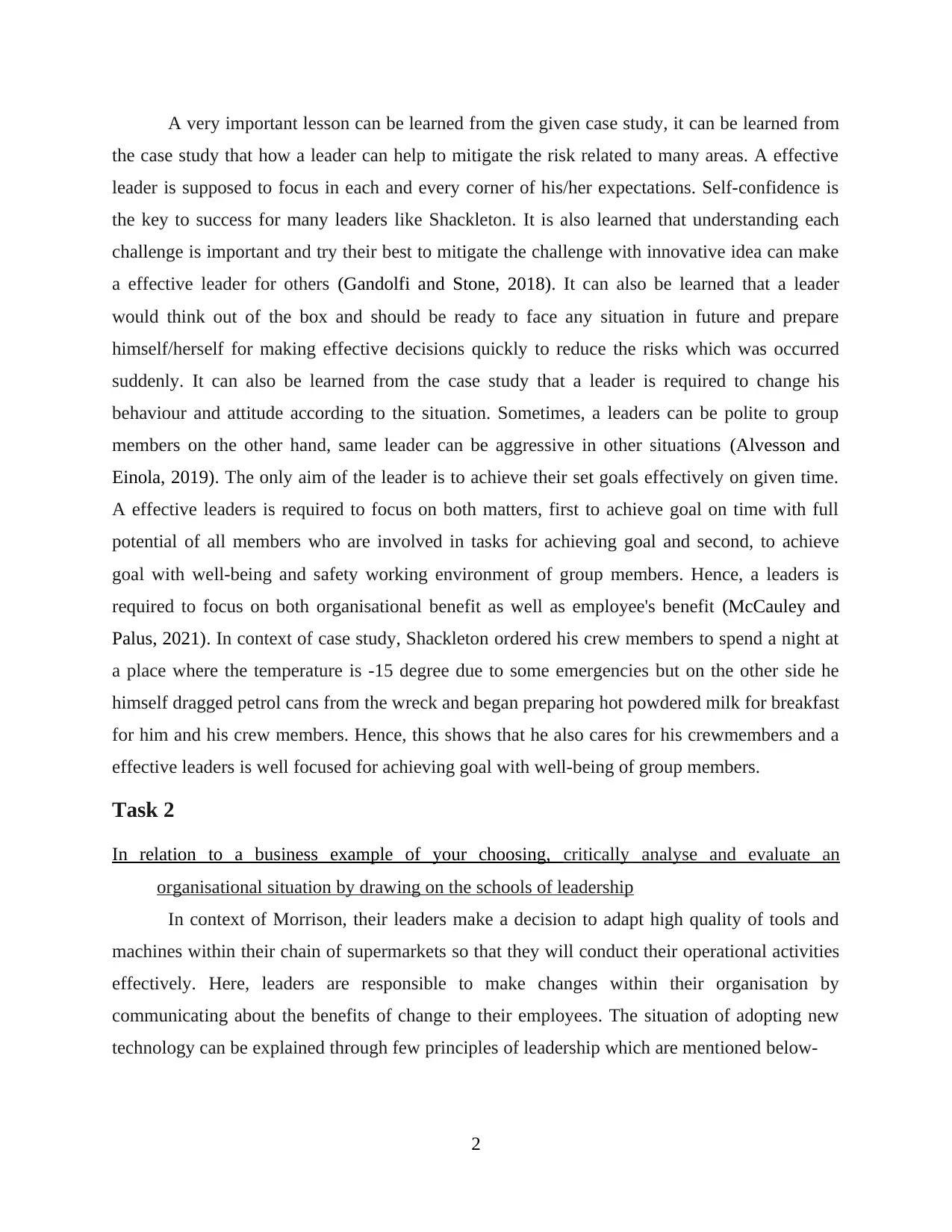
A very important lesson can be learned from the given case study, it can be learned from
the case study that how a leader can help to mitigate the risk related to many areas. A effective
leader is supposed to focus in each and every corner of his/her expectations. Self-confidence is
the key to success for many leaders like Shackleton. It is also learned that understanding each
challenge is important and try their best to mitigate the challenge with innovative idea can make
a effective leader for others (Gandolfi and Stone, 2018). It can also be learned that a leader
would think out of the box and should be ready to face any situation in future and prepare
himself/herself for making effective decisions quickly to reduce the risks which was occurred
suddenly. It can also be learned from the case study that a leader is required to change his
behaviour and attitude according to the situation. Sometimes, a leaders can be polite to group
members on the other hand, same leader can be aggressive in other situations (Alvesson and
Einola, 2019). The only aim of the leader is to achieve their set goals effectively on given time.
A effective leaders is required to focus on both matters, first to achieve goal on time with full
potential of all members who are involved in tasks for achieving goal and second, to achieve
goal with well-being and safety working environment of group members. Hence, a leaders is
required to focus on both organisational benefit as well as employee's benefit (McCauley and
Palus, 2021). In context of case study, Shackleton ordered his crew members to spend a night at
a place where the temperature is -15 degree due to some emergencies but on the other side he
himself dragged petrol cans from the wreck and began preparing hot powdered milk for breakfast
for him and his crew members. Hence, this shows that he also cares for his crewmembers and a
effective leaders is well focused for achieving goal with well-being of group members.
Task 2
In relation to a business example of your choosing, critically analyse and evaluate an
organisational situation by drawing on the schools of leadership
In context of Morrison, their leaders make a decision to adapt high quality of tools and
machines within their chain of supermarkets so that they will conduct their operational activities
effectively. Here, leaders are responsible to make changes within their organisation by
communicating about the benefits of change to their employees. The situation of adopting new
technology can be explained through few principles of leadership which are mentioned below-
2
the case study that how a leader can help to mitigate the risk related to many areas. A effective
leader is supposed to focus in each and every corner of his/her expectations. Self-confidence is
the key to success for many leaders like Shackleton. It is also learned that understanding each
challenge is important and try their best to mitigate the challenge with innovative idea can make
a effective leader for others (Gandolfi and Stone, 2018). It can also be learned that a leader
would think out of the box and should be ready to face any situation in future and prepare
himself/herself for making effective decisions quickly to reduce the risks which was occurred
suddenly. It can also be learned from the case study that a leader is required to change his
behaviour and attitude according to the situation. Sometimes, a leaders can be polite to group
members on the other hand, same leader can be aggressive in other situations (Alvesson and
Einola, 2019). The only aim of the leader is to achieve their set goals effectively on given time.
A effective leaders is required to focus on both matters, first to achieve goal on time with full
potential of all members who are involved in tasks for achieving goal and second, to achieve
goal with well-being and safety working environment of group members. Hence, a leaders is
required to focus on both organisational benefit as well as employee's benefit (McCauley and
Palus, 2021). In context of case study, Shackleton ordered his crew members to spend a night at
a place where the temperature is -15 degree due to some emergencies but on the other side he
himself dragged petrol cans from the wreck and began preparing hot powdered milk for breakfast
for him and his crew members. Hence, this shows that he also cares for his crewmembers and a
effective leaders is well focused for achieving goal with well-being of group members.
Task 2
In relation to a business example of your choosing, critically analyse and evaluate an
organisational situation by drawing on the schools of leadership
In context of Morrison, their leaders make a decision to adapt high quality of tools and
machines within their chain of supermarkets so that they will conduct their operational activities
effectively. Here, leaders are responsible to make changes within their organisation by
communicating about the benefits of change to their employees. The situation of adopting new
technology can be explained through few principles of leadership which are mentioned below-
2
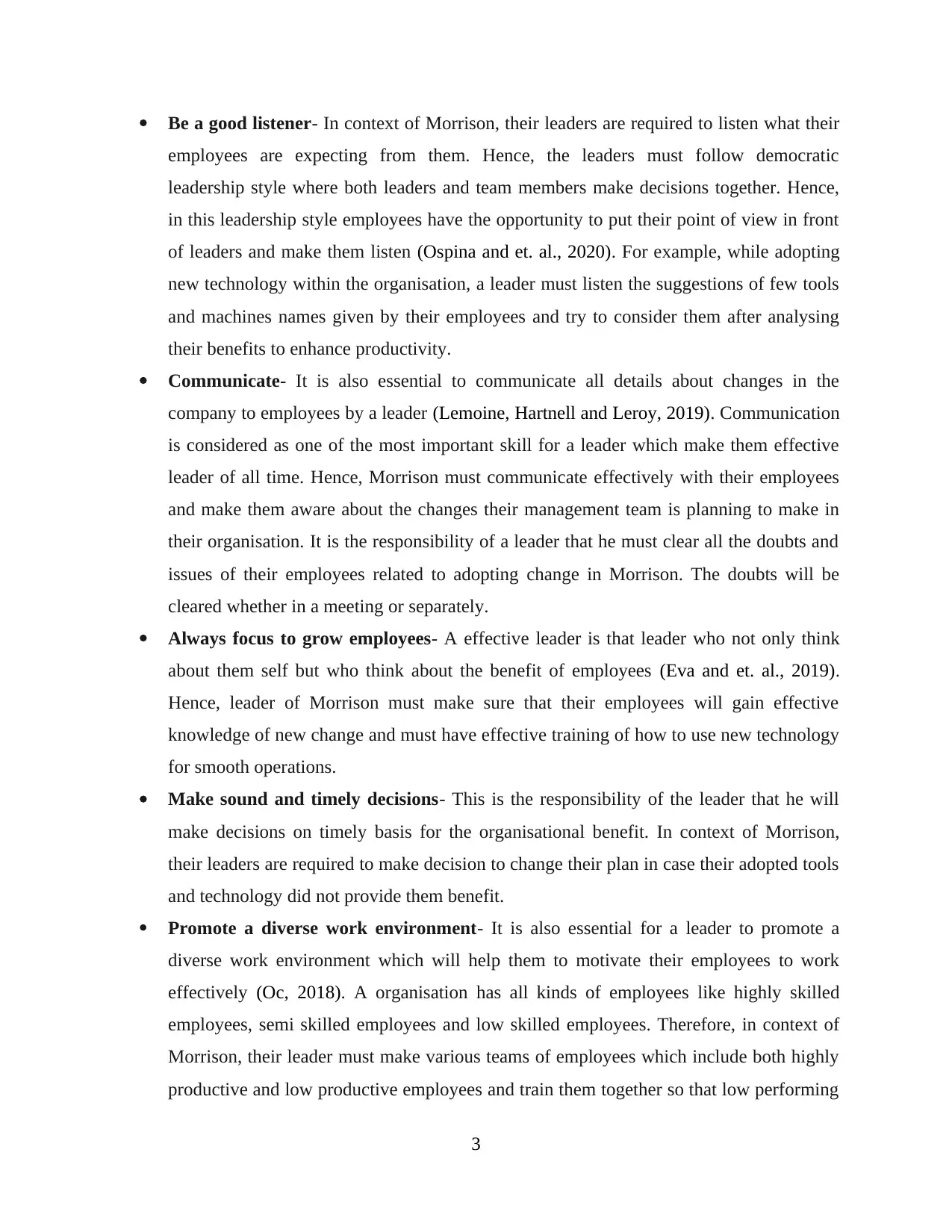
Be a good listener- In context of Morrison, their leaders are required to listen what their
employees are expecting from them. Hence, the leaders must follow democratic
leadership style where both leaders and team members make decisions together. Hence,
in this leadership style employees have the opportunity to put their point of view in front
of leaders and make them listen (Ospina and et. al., 2020). For example, while adopting
new technology within the organisation, a leader must listen the suggestions of few tools
and machines names given by their employees and try to consider them after analysing
their benefits to enhance productivity.
Communicate- It is also essential to communicate all details about changes in the
company to employees by a leader (Lemoine, Hartnell and Leroy, 2019). Communication
is considered as one of the most important skill for a leader which make them effective
leader of all time. Hence, Morrison must communicate effectively with their employees
and make them aware about the changes their management team is planning to make in
their organisation. It is the responsibility of a leader that he must clear all the doubts and
issues of their employees related to adopting change in Morrison. The doubts will be
cleared whether in a meeting or separately.
Always focus to grow employees- A effective leader is that leader who not only think
about them self but who think about the benefit of employees (Eva and et. al., 2019).
Hence, leader of Morrison must make sure that their employees will gain effective
knowledge of new change and must have effective training of how to use new technology
for smooth operations.
Make sound and timely decisions- This is the responsibility of the leader that he will
make decisions on timely basis for the organisational benefit. In context of Morrison,
their leaders are required to make decision to change their plan in case their adopted tools
and technology did not provide them benefit.
Promote a diverse work environment- It is also essential for a leader to promote a
diverse work environment which will help them to motivate their employees to work
effectively (Oc, 2018). A organisation has all kinds of employees like highly skilled
employees, semi skilled employees and low skilled employees. Therefore, in context of
Morrison, their leader must make various teams of employees which include both highly
productive and low productive employees and train them together so that low performing
3
employees are expecting from them. Hence, the leaders must follow democratic
leadership style where both leaders and team members make decisions together. Hence,
in this leadership style employees have the opportunity to put their point of view in front
of leaders and make them listen (Ospina and et. al., 2020). For example, while adopting
new technology within the organisation, a leader must listen the suggestions of few tools
and machines names given by their employees and try to consider them after analysing
their benefits to enhance productivity.
Communicate- It is also essential to communicate all details about changes in the
company to employees by a leader (Lemoine, Hartnell and Leroy, 2019). Communication
is considered as one of the most important skill for a leader which make them effective
leader of all time. Hence, Morrison must communicate effectively with their employees
and make them aware about the changes their management team is planning to make in
their organisation. It is the responsibility of a leader that he must clear all the doubts and
issues of their employees related to adopting change in Morrison. The doubts will be
cleared whether in a meeting or separately.
Always focus to grow employees- A effective leader is that leader who not only think
about them self but who think about the benefit of employees (Eva and et. al., 2019).
Hence, leader of Morrison must make sure that their employees will gain effective
knowledge of new change and must have effective training of how to use new technology
for smooth operations.
Make sound and timely decisions- This is the responsibility of the leader that he will
make decisions on timely basis for the organisational benefit. In context of Morrison,
their leaders are required to make decision to change their plan in case their adopted tools
and technology did not provide them benefit.
Promote a diverse work environment- It is also essential for a leader to promote a
diverse work environment which will help them to motivate their employees to work
effectively (Oc, 2018). A organisation has all kinds of employees like highly skilled
employees, semi skilled employees and low skilled employees. Therefore, in context of
Morrison, their leader must make various teams of employees which include both highly
productive and low productive employees and train them together so that low performing
3
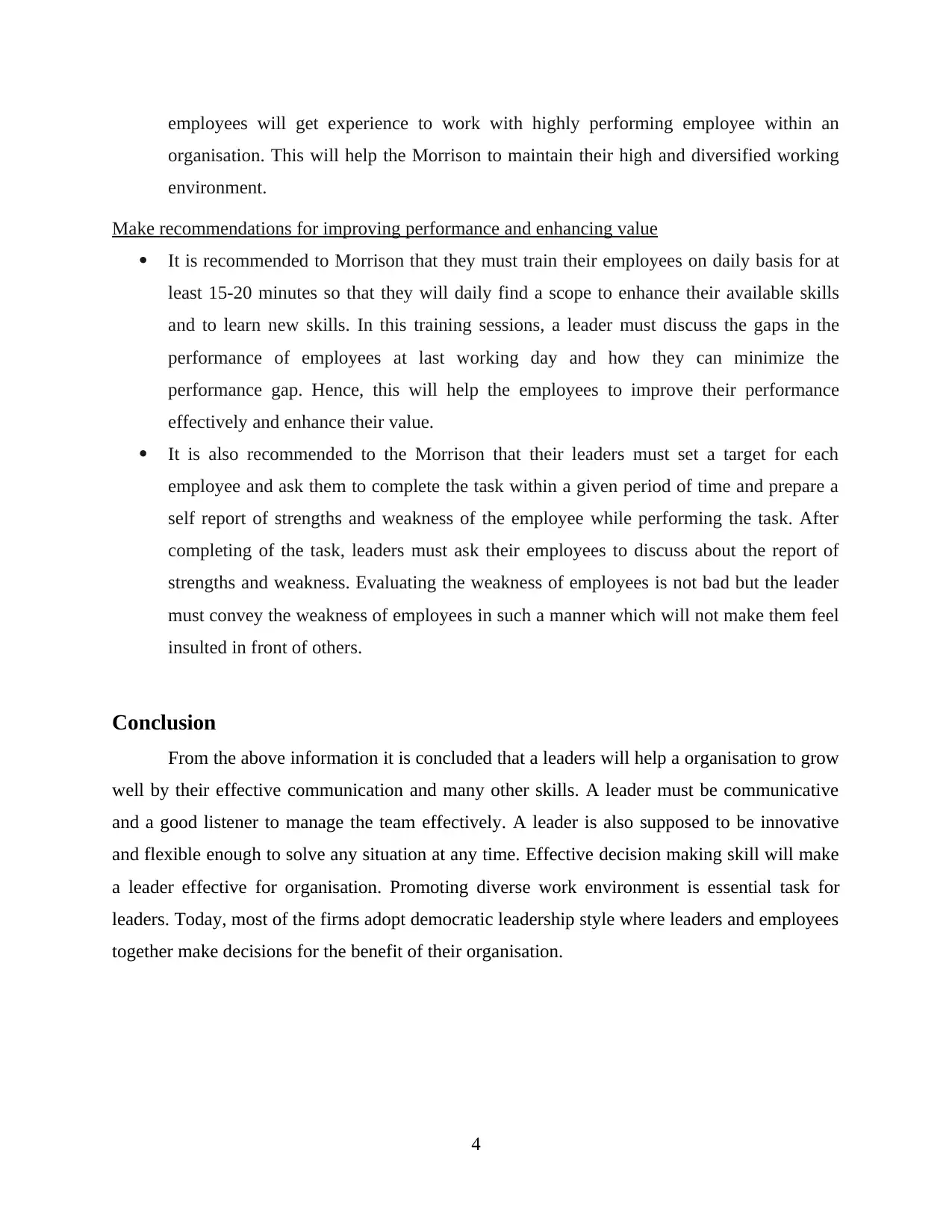
employees will get experience to work with highly performing employee within an
organisation. This will help the Morrison to maintain their high and diversified working
environment.
Make recommendations for improving performance and enhancing value
It is recommended to Morrison that they must train their employees on daily basis for at
least 15-20 minutes so that they will daily find a scope to enhance their available skills
and to learn new skills. In this training sessions, a leader must discuss the gaps in the
performance of employees at last working day and how they can minimize the
performance gap. Hence, this will help the employees to improve their performance
effectively and enhance their value.
It is also recommended to the Morrison that their leaders must set a target for each
employee and ask them to complete the task within a given period of time and prepare a
self report of strengths and weakness of the employee while performing the task. After
completing of the task, leaders must ask their employees to discuss about the report of
strengths and weakness. Evaluating the weakness of employees is not bad but the leader
must convey the weakness of employees in such a manner which will not make them feel
insulted in front of others.
Conclusion
From the above information it is concluded that a leaders will help a organisation to grow
well by their effective communication and many other skills. A leader must be communicative
and a good listener to manage the team effectively. A leader is also supposed to be innovative
and flexible enough to solve any situation at any time. Effective decision making skill will make
a leader effective for organisation. Promoting diverse work environment is essential task for
leaders. Today, most of the firms adopt democratic leadership style where leaders and employees
together make decisions for the benefit of their organisation.
4
organisation. This will help the Morrison to maintain their high and diversified working
environment.
Make recommendations for improving performance and enhancing value
It is recommended to Morrison that they must train their employees on daily basis for at
least 15-20 minutes so that they will daily find a scope to enhance their available skills
and to learn new skills. In this training sessions, a leader must discuss the gaps in the
performance of employees at last working day and how they can minimize the
performance gap. Hence, this will help the employees to improve their performance
effectively and enhance their value.
It is also recommended to the Morrison that their leaders must set a target for each
employee and ask them to complete the task within a given period of time and prepare a
self report of strengths and weakness of the employee while performing the task. After
completing of the task, leaders must ask their employees to discuss about the report of
strengths and weakness. Evaluating the weakness of employees is not bad but the leader
must convey the weakness of employees in such a manner which will not make them feel
insulted in front of others.
Conclusion
From the above information it is concluded that a leaders will help a organisation to grow
well by their effective communication and many other skills. A leader must be communicative
and a good listener to manage the team effectively. A leader is also supposed to be innovative
and flexible enough to solve any situation at any time. Effective decision making skill will make
a leader effective for organisation. Promoting diverse work environment is essential task for
leaders. Today, most of the firms adopt democratic leadership style where leaders and employees
together make decisions for the benefit of their organisation.
4
Paraphrase This Document
Need a fresh take? Get an instant paraphrase of this document with our AI Paraphraser
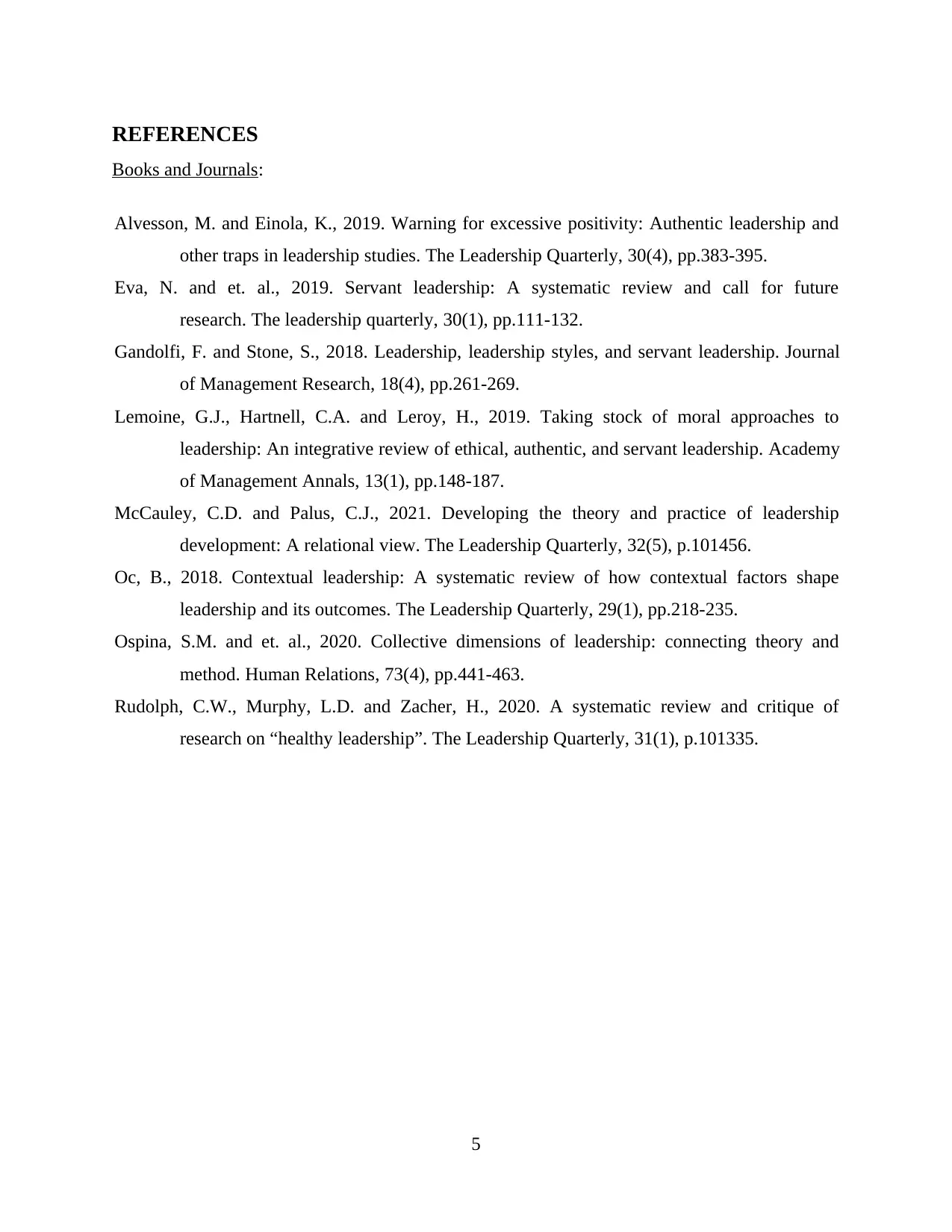
REFERENCES
Books and Journals:
Alvesson, M. and Einola, K., 2019. Warning for excessive positivity: Authentic leadership and
other traps in leadership studies. The Leadership Quarterly, 30(4), pp.383-395.
Eva, N. and et. al., 2019. Servant leadership: A systematic review and call for future
research. The leadership quarterly, 30(1), pp.111-132.
Gandolfi, F. and Stone, S., 2018. Leadership, leadership styles, and servant leadership. Journal
of Management Research, 18(4), pp.261-269.
Lemoine, G.J., Hartnell, C.A. and Leroy, H., 2019. Taking stock of moral approaches to
leadership: An integrative review of ethical, authentic, and servant leadership. Academy
of Management Annals, 13(1), pp.148-187.
McCauley, C.D. and Palus, C.J., 2021. Developing the theory and practice of leadership
development: A relational view. The Leadership Quarterly, 32(5), p.101456.
Oc, B., 2018. Contextual leadership: A systematic review of how contextual factors shape
leadership and its outcomes. The Leadership Quarterly, 29(1), pp.218-235.
Ospina, S.M. and et. al., 2020. Collective dimensions of leadership: connecting theory and
method. Human Relations, 73(4), pp.441-463.
Rudolph, C.W., Murphy, L.D. and Zacher, H., 2020. A systematic review and critique of
research on “healthy leadership”. The Leadership Quarterly, 31(1), p.101335.
5
Books and Journals:
Alvesson, M. and Einola, K., 2019. Warning for excessive positivity: Authentic leadership and
other traps in leadership studies. The Leadership Quarterly, 30(4), pp.383-395.
Eva, N. and et. al., 2019. Servant leadership: A systematic review and call for future
research. The leadership quarterly, 30(1), pp.111-132.
Gandolfi, F. and Stone, S., 2018. Leadership, leadership styles, and servant leadership. Journal
of Management Research, 18(4), pp.261-269.
Lemoine, G.J., Hartnell, C.A. and Leroy, H., 2019. Taking stock of moral approaches to
leadership: An integrative review of ethical, authentic, and servant leadership. Academy
of Management Annals, 13(1), pp.148-187.
McCauley, C.D. and Palus, C.J., 2021. Developing the theory and practice of leadership
development: A relational view. The Leadership Quarterly, 32(5), p.101456.
Oc, B., 2018. Contextual leadership: A systematic review of how contextual factors shape
leadership and its outcomes. The Leadership Quarterly, 29(1), pp.218-235.
Ospina, S.M. and et. al., 2020. Collective dimensions of leadership: connecting theory and
method. Human Relations, 73(4), pp.441-463.
Rudolph, C.W., Murphy, L.D. and Zacher, H., 2020. A systematic review and critique of
research on “healthy leadership”. The Leadership Quarterly, 31(1), p.101335.
5
1 out of 8
Related Documents
Your All-in-One AI-Powered Toolkit for Academic Success.
+13062052269
info@desklib.com
Available 24*7 on WhatsApp / Email
![[object Object]](/_next/static/media/star-bottom.7253800d.svg)
Unlock your academic potential
© 2024 | Zucol Services PVT LTD | All rights reserved.
